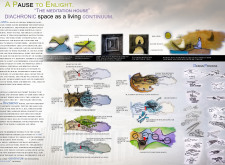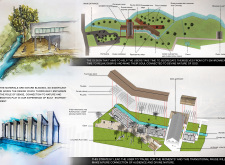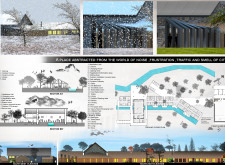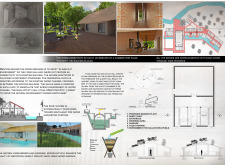5 key facts about this project
The design of the Meditation House emphasizes harmony and coherence with its natural surroundings. It incorporates a series of interconnected spaces that invite occupants to explore different states of being. The architectural layout promotes movement through the site, with pathways leading to outdoor meditation areas, yoga decks, and reflective gardens. Each area is strategically placed to maximize views of the landscape and provide a natural backdrop for the users' experiences.
Key components of the project include a central corridor that connects different functional spaces, such as meditation halls, communal areas for group activities, and private rooms for individual reflection. The thoughtful organization allows users to transition smoothly between indoor and outdoor environments, fostering a sense of continuity and flow that is central to the experience the house aims to provide.
Materiality plays a significant role in the design approach of the Meditation House. The use of natural materials, including wood and stone, reinforces the connection to nature while ensuring durability and sustainability. Glass is integrated to maximize natural light, creating luminous spaces that enhance the overall ambiance of the interior. Furthermore, the thatched roof is a traditional element that connects the contemporary structure with local architectural vernacular, highlighting a thoughtful consideration of the region’s cultural context.
One of the unique design approaches employed in the Meditation House is the integration of water features and green spaces throughout the site. This not only enhances aesthetic appeal but also contributes to the overall sensory experience of the environment. The presence of water promotes tranquility, while the arrangement of greenery provides a sense of enclosure and privacy, essential for introspective activities. The careful placements of these elements serve to encourage a deep interaction between the occupants and the nature surrounding them.
Another defining characteristic is the emphasis on light and air movement throughout the architecture. Skylights and strategically positioned windows facilitate natural ventilation and daylighting, further merging the interior spaces with the outdoor environment. This not only reduces energy consumption but also creates environments conducive to relaxation and meditation, allowing users to experience the play of light throughout different times of the day.
Sustainability is woven into the architectural design on multiple levels. The use of renewable materials, the emphasis on natural light, and the implementation of a biogas harvesting system are examples of how the Meditation House aligns with eco-friendly practices. These design strategies reflect a growing awareness within the architectural community of the need for responsible and sustainable building practices.
The Meditation House exemplifies an architectural project that prioritizes user experience, connection to nature, and sustainability. It serves as a model for designs that look to blend the built environment with natural landscapes while offering users a unique space for reflection and rejuvenation. Those interested in delving deeper into the nuances of the design, including architectural plans, sections, and the innovative architectural ideas that informed its development, are encouraged to explore the complete project presentation for a comprehensive understanding of its significance and impact.


























